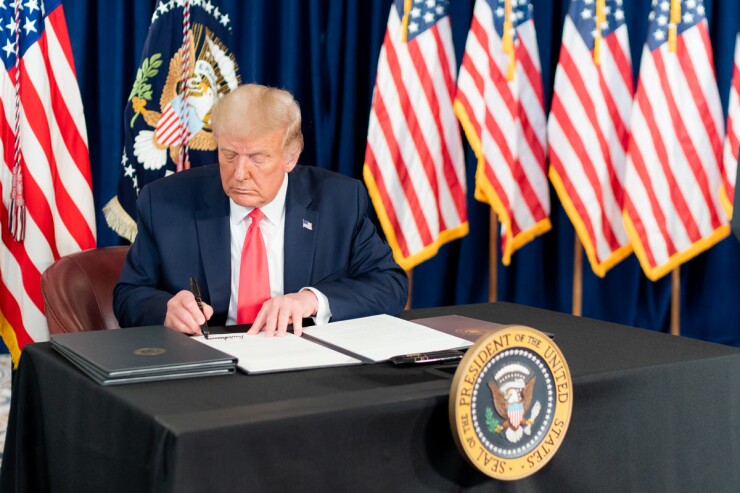The American Institute of CPAs has sent a letter to top officials at the Treasury Department and the Internal Revenue Service asking for more guidance and clarification on President Trump’s
President Trump ordered the payroll tax deferral over the weekend as one of four executive orders aimed at providing a boost to the flagging economy amid the novel coronavirus pandemic. Negotiations broke down last week between Democrats in Congress and administration officials over another stimulus package to deal with the expiration of enhanced unemployment benefits and the eviction moratorium, extension of the Paycheck Protection Program and deferral of student loan payments, another round of stimulus checks, state and local government funding and other issues.
Trump’s executive orders include some money for unemployment benefits, but not at the $600 level under the earlier CARES Act, as well as studying the eviction moratorium, deferring student loan payments, and implementing Trump’s long-standing desire for payroll tax cuts. However, an actual tax cut would require an act of Congress, so the executive order only calls for deferring the collection of the employee’s share of payroll taxes from Sept. 1 until the end of the year. The executive order is vague about a number of issues and leaves it to the Treasury to work out the details. That has left payroll service providers, accountants and many businesses anxious to get the regulations before the executive order takes effect at the beginning of next month (

The order only addresses the 6.2 percent employee’s share of Social Security taxes but doesn’t apply to the 1.45 percent employee’s share of Medicare taxes, according to a
In a letter Wednesday, the AICPA asked Assistant Treasury Secretary David Kautter and IRS Commissioner Charles Rettig to provide guidance to address several concerns prompted by the order, including:
- Guidance stating that the deferral is voluntary and that an “eligible employee” is responsible for making an affirmative election to defer the payroll taxes.
- Guidance specifying that an “eligible employee” is an employee whose wages are less than $4,000 per biweekly pay period.
- Guidance saying that the $4,000 limit should apply separately to each employer of an employee.
- Guidance stating a payment due date(s) for the deferred taxes and a mechanism for employees to pay the deferred taxes.
Treasury Secretary Steven Mnuchin said earlier this week the payroll tax deferral would not be mandatory for employers to implement, the AICPA noted. Employees can also opt out of having the payroll taxes deferred so they don’t get hit with a big tax bill next year.
“Since the taxes being discussed are those ‘imposed on the income of each employee,’ a big question we have is whether or not employees will have the option to opt in or out of the program,” said AICPA vice president of taxation, Edward Karl in a statement. “Employees should make the deferral decision and should also be responsible for repayment; however, there are certain questions that need to be considered that taxpayers and businesses need guidance on. For example, what if an employee works more than one job? What if the company goes out of business? What if the employee changes jobs? Employers still have to figure out how to implement this policy, but right now, there are too many unknowns.”
The U.S. Chamber of Congress sent its own
“As taxpayers delve further into this EO, questions arise about how to apply this in other situations, such as where employees have fluctuating salaries or receive bonuses; where employees are employed for a short term, such as with seasonal holiday workers; and where employees leave employment prior to the end of the deferral period,” Harris added. “The uncertainty raised by these issues, as well as myriad other issues not enumerated here, only exacerbates the challenges faced by payroll processors and compliance departments who are already struggling to implement this EO in an extremely short period of time. Not only is the payroll EO surrounded by uncertainty as to its application and implementation, it creates a substantial tax liability for employees at the end of the deferral period. As current law provides, this is a deferral of tax due, and without congressional action to forgive the payroll tax, it threatens to impose serious hardships on employees who will face a large tax bill at the end of the deferral period.”





